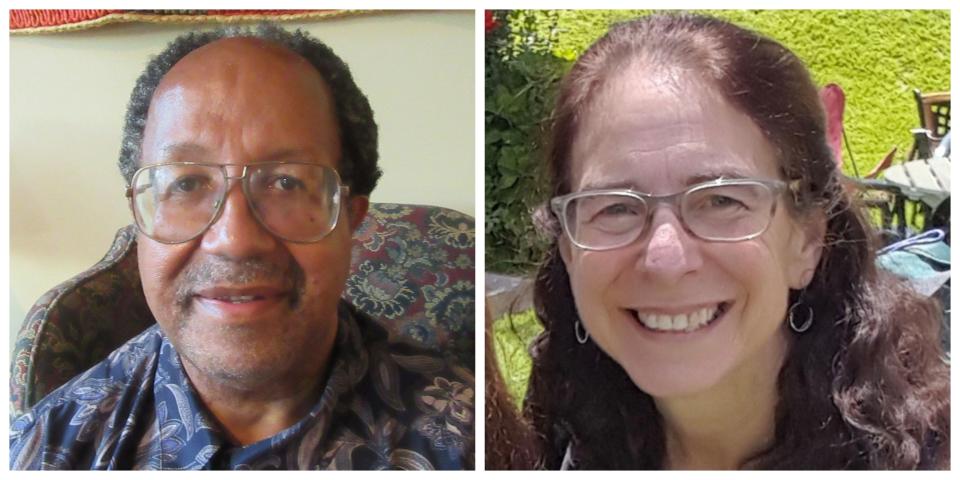Extreme weather: Views from South Berwick, Maine and Tuskegee, Alabama. Color Us Connected
- Oops!Something went wrong.Please try again later.
- Oops!Something went wrong.Please try again later.
This column appears every other week in Foster’s Daily Democrat and the Tuskegee News. This week, Guy Trammell, an African American man from Tuskegee, Ala., and Amy Miller, a white woman from South Berwick, Maine, write about extreme weather.
By Guy Trammell Jr.
On July 4, 1881, Booker T. Washington held Tuskegee University’s first day of class, in an old shanty, on the grounds of Butler Chapel A.M.E. Zion church. Looking through early Tuskegee newspapers in our courthouse, I learned the temperature that day was 105 degrees.
As we face these days of 90-plus degrees, I remember when I was old enough for yard and garden chores and learned to plan outdoor summer duties early in the morning or at sunset. In more recent times, I recall a summer when the heat was so intense that interior rear view mirrors were falling to the floor of Tuskegee vehicles.

In November 1899, Dr. George W. Carver established the first weather station in Macon County, Alabama, and operated it until January 1932. On Weather Bureau Form 1009, Carver recorded the Great Miami Hurricane in September 1926. Possibly the most destructive of all Atlantic storms, it crossed Florida and hit both Alabama and Georgia.
We sometimes get a few inches of snow. However, our major winter destruction comes from ice storms and Alberta Clippers, when the jet stream brings arctic temperatures south. First comes rain, which freezes on tree limbs, and all night you can hear tree limbs snapping under the weight of the ice. This produces power outages and causes water pipes to burst.
Starting in 1941, over 40 African Americans trained to be weathermen for the Tuskegee Air Base during World War II. Fifteen were commissioned as Army Air Force weather officers with the meteorological aviation cadet program. They didn’t just report the weather; they had to make sure base operations were consistent with what the weather allowed. They calculated the conditions for before, during and after the missions. Additionally, they had to continually prove themselves as professionals in a racist and prejudiced environment.
Wallace Patillo Reed was the first African American weather officer in the Air Corps Weather Service. The Tuskegee weather detachment was activated on March 21, 1942. Some of these weather officers were assigned to flying squadrons, including four who traveled with their squadrons to the Mediterranean combat theater.
Tuskegee weather officer Capt. Charles Edward Anderson was the first African American to earn a PhD in meteorology, and received national recognition for his program to forecast severe storms.
As I go to another activity in our intense heat, I think of cookouts with tin tubs of sodas buried in ice, hand cranked churns for delicious ice cream, and also enjoying a fruit popsicle!
By Amy Miller
I’m driving home from northern New Hampshire, a spot in the foothills of the White Mountains that was spared the devastating flooding of neighboring Vermont. But the weather report warns of flooding along the drive south.
I get home safely through lightning storms and torrential downpours only to find myself two days later listening to warnings of a possible tornado in southern Maine. My friend nearby texts me that she always brags about New England escaping the weather woes of the rest of the country. Now she feels contrite.The tornado never materializes, but the next day I am sitting on the dock of a friend, who comments on the smoke hanging low over our local swimming pond. The Canadian wildfires that choked New York earlier this summer have announced their presence in Maine.
And across the globe," heat suffocates humans in a way that seems like the stuff of the dystopian novels", another friend writes.
None of us has answers and none of us feels we can make much difference. One friend runs an air conditioner for her dogs. My son drives a truck ‘cause he loves it. And I still fly when I want to, heat my home with oil, and live in a house much bigger than my needs.
Federal policy seems for the first time to be taking this challenge seriously. Is it too late? I suddenly feel better about artificial intelligence, thinking perhaps it can solve a problem mere mortals cannot. Recently Maine released a new Maine Climate Impact Dashboard (https://www.maine.gov/future/climate/climate-impact-dashboard) with nine interactive maps that tell the story of everything from rising temperatures, heat vulnerability and flooding to health impacts, sea level rise and economic impacts in my state. In a state that depends on forestry, tourism and fishing for much of its economy, the economic impacts are not small. The dashboard also tells how some communities are working to face these challenges.
A Mainer’s Guide to Climate Incentives put out by the state of Maine tells of state and federal incentives and rebates available for everything from heat pumps and weatherstripping to electric cars and solar panels.
My family just got its first electric car and there is indeed a learning curve and an upfront investment. But I have to tell you, it feels great to head to the store without feeling like I am adding to the world’s climate problems. Not to mention how good it feels to pass a gas station and declare it irrelevant. Unless I need a bag of over-priced chips. We know change must happen on a massive scale, driven mainly by government and corporate action. But still, step by step we can each walk in the right direction.
Amy and Guy can be reached at colorusconnected@gmail.com
This article originally appeared on Portsmouth Herald: Extreme weather: Views from South Berwick, Maine and Tuskegee, Alabama

